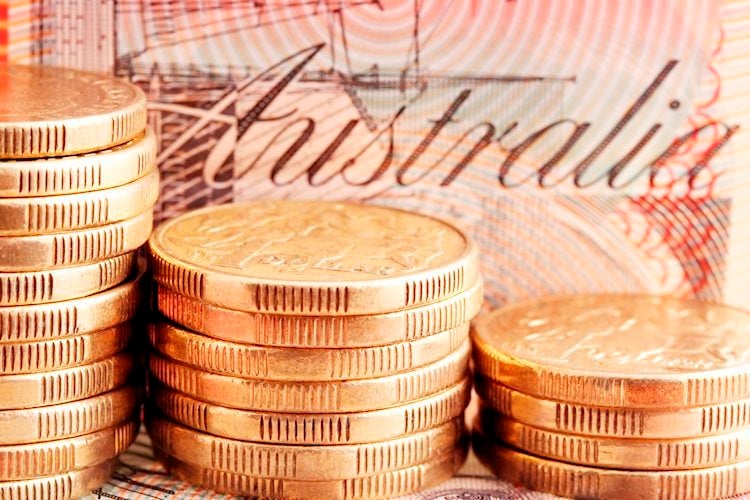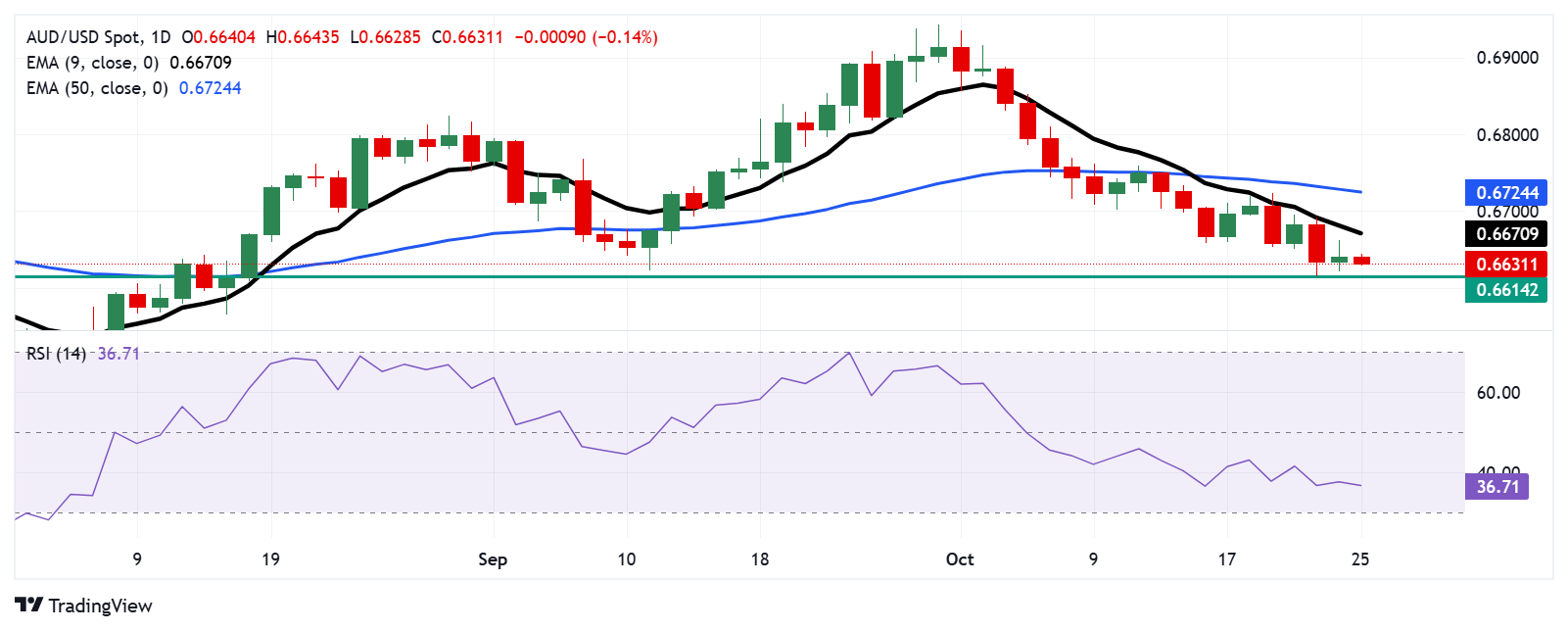- The Australian Dollar loses ground despite the hawkish RBA’s policy outlook.
- The AUD inches lower as the US Dollar appreciates amid less-dovish sentiment surrounding the Fed.
- CME FedWatch Tool suggests a 97% chance of a 25-basis-point rate cut by the Fed in November.
The Australian Dollar (AUD) edged lower against the US Dollar (USD) on Thursday. However, the AUD/USD pair saw some gains as the US Dollar (USD) softened slightly due to a modest decline in US Treasury yields. The Aussie Dollar could benefit from the hawkish tone surrounding the Reserve Bank of Australia (RBA).
RBA Deputy Governor Andrew Hauser highlighted, earlier this week, the country’s strong labor participation rate and stressed that, although the RBA relies on data, it is not overly fixated on it.
The US Dollar has strengthened as traders closely watch the Federal Reserve’s (Fed) interest rate trajectory, amid increasing expectations that the central bank will be less aggressive in lowering rates than previously thought. Additionally, the Greenback is buoyed by rising speculation regarding a potential second term for former President Donald Trump in the upcoming US presidential election in November.
Republican nominee Donald Trump returned to his familiar reality show catchphrase during an event in Las Vegas, Nevada on Thursday. Trump stated, “Under the Trump administration, we’re going to build an economy that lifts up all Americans, including African Americans, Hispanic Americans, and also members of our great Asian American and Pacific Islander community, many of whom are here today,” as reported by Reuters.
Daily Digest Market Movers: Australian Dollar depreciates ahead of US presidential election
- According to the CME FedWatch Tool, there is a 97% probability of a 25-basis-point rate cut by the Fed in November, with no expectation of a larger 50-basis-point cut.
- Vice President Kamala Harris enjoyed the backing of rock legend Bruce Springsteen, entertainer Tyler Perry, and former President Barack Obama at a rally in Georgia, which attracted thousands of supporters in this key battleground state.
- S&P Global has released its preliminary October US Purchasing Managers Index (PMI) readings, showing positive momentum across sectors. The Composite PMI rose to 54.3, up from the previous 54.0. The Services PMI exceeded expectations at 55.3, compared to the forecasted 55.0, and saw a slight increase from the previous 55.2. Meanwhile, the Manufacturing PMI also came in stronger at 47.8, above the expected 47.5, and improving from the prior reading of 47.3.
- Australia’s Judo Bank Composite PMI slightly rose to 49.8 in October, up from 49.6 in September, signaling a second straight month of contraction in private sector output. The Services PMI inched up to 50.6 from 50.5, marking its ninth consecutive month of expansion, while the Manufacturing PMI dipped to 46.6 from 46.7, continuing its decline.
- On Wednesday, the Fed Beige Book indicated that economic activity was “little changed in nearly all Districts,” in contrast to August’s report, in which three Districts reported growth and nine showed flat activity.
- In a post on the social media platform X, Federal Reserve Bank of San Francisco President Mary Daly stated that the economy is clearly in a better position, with inflation having fallen significantly and the labor market returning to a more sustainable path.
- On Monday, Federal Reserve Bank of Minneapolis President Neel Kashkari highlighted that the Fed is closely monitoring the US labor market for signs of rapid destabilization. Kashkari cautioned investors to anticipate a gradual pace of rate cuts over the coming quarters, suggesting that any monetary easing will likely be moderate rather than aggressive.
- The People’s Bank of China (PBoC) reduced the 1-year Loan Prime Rate (LPR) to 3.10% from 3.35% and the 5-year LPR to 3.60% from 3.85%, which is in line with expectations. Lower borrowing costs are anticipated to stimulate China’s domestic economic activity, potentially increasing demand for Australian exports.
- National Australia Bank revised its projection for the Reserve Bank of Australia (RBA) in a note last week. “We have brought forward our expectations for the timing of rate cuts, now anticipating the first cut in February 2025, instead of May,” the bank stated. They continue to foresee gradual cuts, with rates expected to decrease to 3.10% by early 2026.
Technical Analysis: Australian Dollar stays below 0.6650, close to two-month lows
The AUD/USD pair trades around 0.6640 on Thursday, with technical analysis of the daily chart indicating a short-term bearish trend. The pair remains below the nine-day Exponential Moving Average (EMA), and the 14-day Relative Strength Index (RSI) is below 50, further confirming bearish bias.
On the support side, the AUD/USD pair is testing its two-month low of 0.6614, reached on Wednesday. The next major support level lies at the psychological threshold of 0.6600.
Regarding the upside, resistance is anticipated at the nine-day EMA at 0.6672, followed by the 50-day EMA at 0.6724. A break above these resistance levels could pave the way for a potential move toward the psychological barrier of 0.6800.
AUD/USD: Daily Chart
Australian Dollar PRICE Today
The table below shows the percentage change of Australian Dollar (AUD) against listed major currencies today. Australian Dollar was the weakest against the Japanese Yen.
| USD | EUR | GBP | JPY | CAD | AUD | NZD | CHF | |
|---|---|---|---|---|---|---|---|---|
| USD | 0.04% | 0.08% | -0.09% | -0.01% | 0.29% | 0.36% | 0.01% | |
| EUR | -0.04% | 0.05% | -0.13% | -0.05% | 0.23% | 0.32% | -0.03% | |
| GBP | -0.08% | -0.05% | -0.20% | -0.11% | 0.18% | 0.26% | -0.13% | |
| JPY | 0.09% | 0.13% | 0.20% | 0.09% | 0.38% | 0.45% | 0.09% | |
| CAD | 0.00% | 0.05% | 0.11% | -0.09% | 0.29% | 0.37% | -0.03% | |
| AUD | -0.29% | -0.23% | -0.18% | -0.38% | -0.29% | 0.09% | -0.29% | |
| NZD | -0.36% | -0.32% | -0.26% | -0.45% | -0.37% | -0.09% | -0.39% | |
| CHF | -0.01% | 0.03% | 0.13% | -0.09% | 0.03% | 0.29% | 0.39% |
The heat map shows percentage changes of major currencies against each other. The base currency is picked from the left column, while the quote currency is picked from the top row. For example, if you pick the Australian Dollar from the left column and move along the horizontal line to the US Dollar, the percentage change displayed in the box will represent AUD (base)/USD (quote).
Risk sentiment FAQs
In the world of financial jargon the two widely used terms “risk-on” and “risk off” refer to the level of risk that investors are willing to stomach during the period referenced. In a “risk-on” market, investors are optimistic about the future and more willing to buy risky assets. In a “risk-off” market investors start to ‘play it safe’ because they are worried about the future, and therefore buy less risky assets that are more certain of bringing a return, even if it is relatively modest.
Typically, during periods of “risk-on”, stock markets will rise, most commodities – except Gold – will also gain in value, since they benefit from a positive growth outlook. The currencies of nations that are heavy commodity exporters strengthen because of increased demand, and Cryptocurrencies rise. In a “risk-off” market, Bonds go up – especially major government Bonds – Gold shines, and safe-haven currencies such as the Japanese Yen, Swiss Franc and US Dollar all benefit.
The Australian Dollar (AUD), the Canadian Dollar (CAD), the New Zealand Dollar (NZD) and minor FX like the Ruble (RUB) and the South African Rand (ZAR), all tend to rise in markets that are “risk-on”. This is because the economies of these currencies are heavily reliant on commodity exports for growth, and commodities tend to rise in price during risk-on periods. This is because investors foresee greater demand for raw materials in the future due to heightened economic activity.
The major currencies that tend to rise during periods of “risk-off” are the US Dollar (USD), the Japanese Yen (JPY) and the Swiss Franc (CHF). The US Dollar, because it is the world’s reserve currency, and because in times of crisis investors buy US government debt, which is seen as safe because the largest economy in the world is unlikely to default. The Yen, from increased demand for Japanese government bonds, because a high proportion are held by domestic investors who are unlikely to dump them – even in a crisis. The Swiss Franc, because strict Swiss banking laws offer investors enhanced capital protection.

